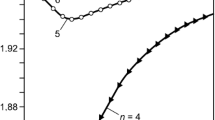Conclusions
The error in calculating the resultant error of instruments by the method described in [2] depends on the shape of the component distribution functions, on the square of the histogram interval length, and on the number of experimental data. This error depends most of all on the length of the histogram interval. By reducing the length of histogram intervals and, therefore, increasing their number, the amount of calculations increases, and it is advisable to obtain solutions, as indicated in [1], by means of computers. It should be noted that for raising the number of intervals it is necessary to have a larger number of experimental data.
Similar content being viewed by others
Literature cited
S. G. Rabinovich, Izmeritel'. Tekh., No. 2 (1968).
I. A. Grachev and S. G. Rabinovich, Izmeritel'. Tekh., No. 1 (1968).
G. Cramer, Mathematical Methods in Statistics [Russian translation], IIL, Moscow (1948).
Additional information
Translated from Izmeritel'naya Tekhnika, No. 1, pp. 72–75, January, 1971.
Rights and permissions
About this article
Cite this article
Kudryashova, Z.F. Analysis of the technique for computing instruments' resulting error. Meas Tech 14, 113–118 (1971). https://doi.org/10.1007/BF00982262
Received:
Issue Date:
DOI: https://doi.org/10.1007/BF00982262




